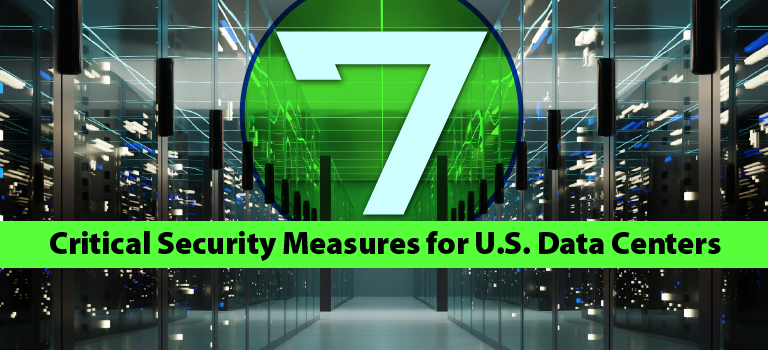Data centers in the United States encounter all kinds of digital and physical security threats. They have to use every resource available to protect their precious information and keep their systems operational.
Here are seven critical security measures U.S. data centers must utilize to counteract threats.
Software Security
Malware and Distributed-Denial-of-Service (DDoS) attacks are becoming all too common. Data breaches have exploded by 167 percent for internet users worldwide, meaning global software security has much room for improvement. These practices can right the ship and protect people’s private information.
1. Zero-Trust Model
The zero-trust security model is a straightforward approach that assumes all network activity is a potential threat. It forces the data center’s cybersecurity team to stay on high alert and investigate new traffic as it appears. This kind of vigilance can significantly reduce the chance of a data breach. It’s a strong foundation for any organization’s software security efforts.
A zero-trust policy becomes more critical as the world’s online transformation continues. Security teams have many more threats to manage, but they can’t keep up, judging by the data breach statistics. They don’t have the time or insights to stop all suspicious activity. The only rational solution is simplifying the monitoring process and assuming everything is dangerous.
2. SIEM Tools
Security Information and Event Management (SIEM) tools provide real-time data center activity visibility. They can scan user devices, security equipment, applications, and new code additions for vulnerabilities. Data centers can gather a SIEM tool’s findings in one place, making pattern recognition and breach detection more efficient.
It’s challenging for humans to find malware inside unsuspicious traffic without Machine Learning. SIEM tools have built-in AI that automates supervision and makes the lives of cybersecurity professionals easier. They even offer detailed performance metrics and potential solutions to emerging threats.
3. Network Segmentation
A network without layers can expose all its data in one breach. That’s why network segmentation is so important. Data centers need to create multiple zones in their networks to add more layers of security.
A common arrangement is a three-zone network with a testing, development, and production zone. The testing area contains minimal actual data, but it allows cybersecurity administrators to experiment with their new security measures. The development zone is where the security measures are perfected before being approved for the production zone.
4. Routine Maintenance
Data centers must routinely review and update their security practices. They should start by replacing their server hardware at least every three years to add storage capacity and improve performance. Frequent software patches are also crucial for preventing repeated cyber-attacks from the same source.
Frequent back-ups are enormous parts of a data center’s maintenance for many reasons. They reverse unsuccessful updates, fix software compatibility issues, and help data centers regain control of their networks if a cyber-attack occurs.
Physical Security
A data center’s building also faces threats from intruders and untrustworthy employees. Natural disasters like floods and earthquakes also come into play in specific locations. Data centers in New York City, Washington D.C. and other cities with geopolitical relevance are desirable targets for international criminals. Here’s how data centers can address these threats:
5. Access Limitation
Every data center should only have a few entry points, including windows. Cameras, alarms, light systems, metal detectors and other conventional security devices should be present throughout the facility. The building itself must also be able to withstand brute force attacks from vehicles and handheld tools.
Strict authorization standards might be necessary to protect the building’s most private areas. Armed security teams are occasionally employed by larger companies to protect particularly sensitive areas. If an organization intends on going this route, they need to ensure the team has training, abides by proper safety precautions and knows the building’s layout by heart.
Some data centers also have raised floors to protect their network’s wiring. This design makes it easier to access the wires for maintenance while providing better ventilation to prevent overheating.
6. Employee Training
An organization’s employees largely determine its vulnerability to cyber-attacks. A data center’s most valuable asset is a well-trained workforce that can identify phishing attempts and responsibly share information. Each staff member must take the building’s authorization steps seriously and maintain constant communication with the security team.
Employees should also be careful about sharing their driving information because it might reveal sensitive data about their behavior. Criminals can use this data to identify and exploit weaknesses in the data center’s workforce.
Natural disasters can be just as debilitating as human-made cyber-attacks. Data centers must implement the necessary safeguards to protect their workers and information. Fires have crippled data centers before due to system overheating, so a sprinkler system is a must-have. Pest traps and water leakage detectors are also crucial for protecting the building’s hardware.
Lastly, detailed emergency procedures must be in place for natural disasters, burglars, and active shooters. Evacuation maps should be in every room and hallway with easy-to-read steps. Data centers can help their staff memorize these procedures with random drills.
7. Alternative Power Sources
Data centers are electricity hubs, so they can’t afford to rely on a single power source. They must have at least one alternative power source as a backup plan. The most common options are solar or wind power generators and uninterruptible power source batteries. Surge protectors are also necessary to control the data center’s excess voltage.
Data Centers Need Well-Rounded Security
Digital and physical attacks on a data center can be equally devastating, which means they need a well-rounded security system. These seven security measures cover many external threats, but they all have the same underlying message — constant vigilance. An attack can come from anywhere at any time. There’s never a dull moment in data center security.
Oscar Collins
Tags: Data Centers, Employee Training, SIEM


